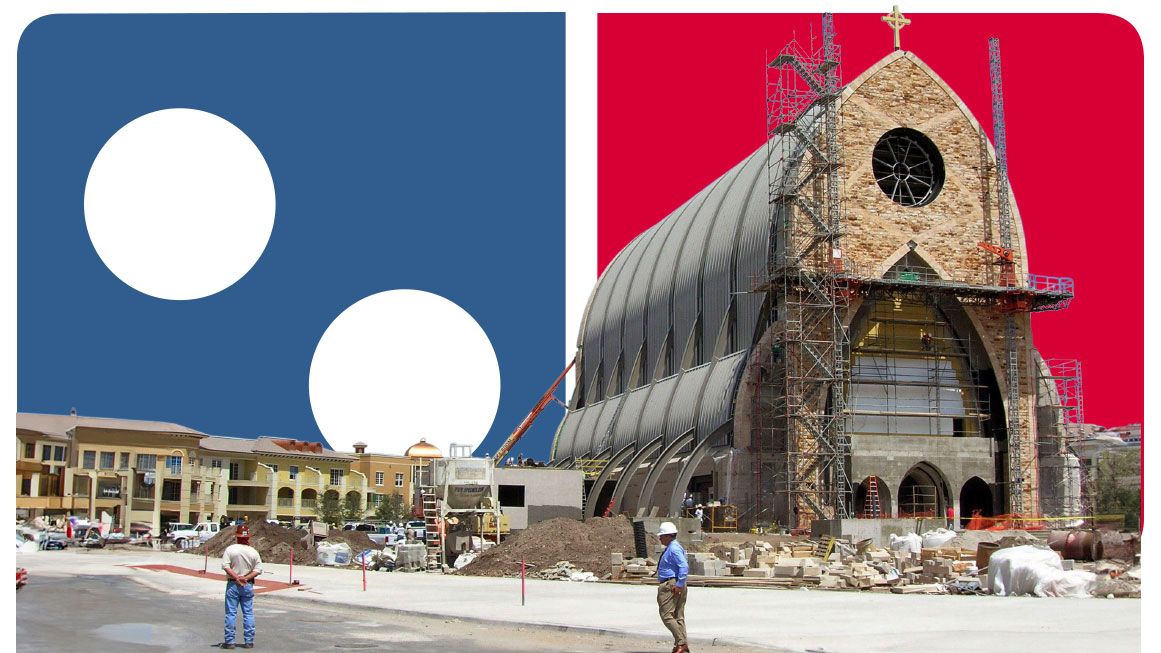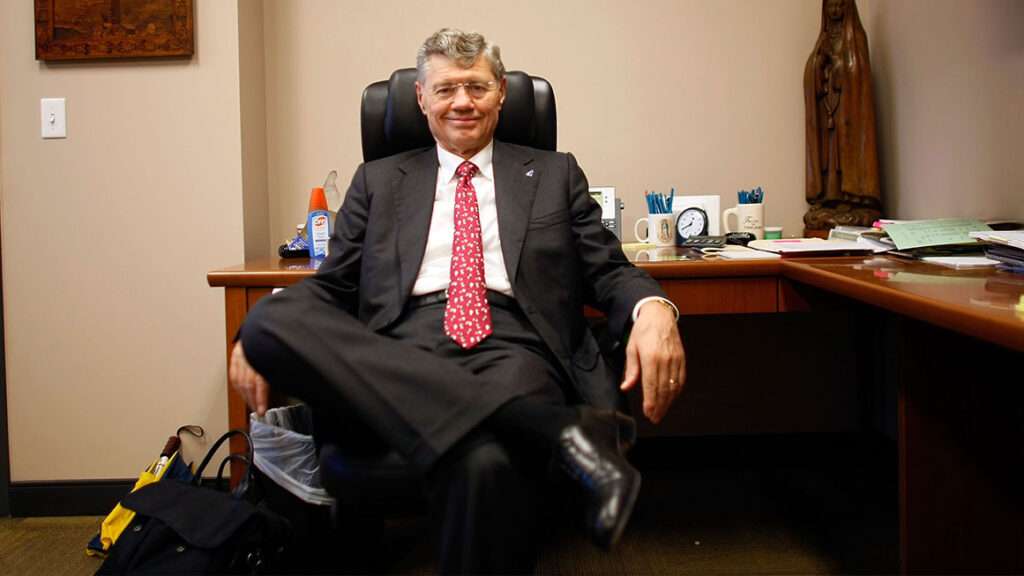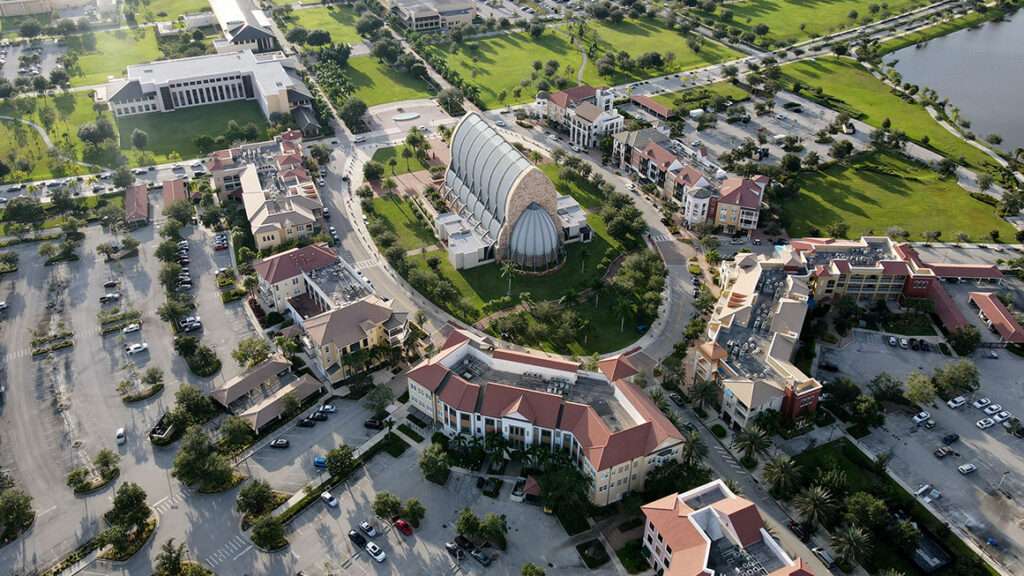The Great American City Upon a Hill Is Always Under Construction
American history is often a story of people leaving to try to build their voluntary utopias.

By any reasonable criteria, Ave Maria should not exist. An hour inland from Naples and Fort Myers, the closest major cities, the Florida town sits alone amid a harsh landscape of fallow ranches and industrial citrus farms. Nearly the entire development, except downtown, is a flood zone. In May, the daily high creeps above 90 degrees Fahrenheit and does not come back down until October. The only major employer, assuming residents of $750,000 homes are not picking oranges, is Ave Maria University.
The city was willed into existence by Tom Monaghan, founder of Domino's Pizza. After selling his stake in the chain for $1 billion, Monaghan—a devout Catholic and collector of Frank Lloyd Wright memorabilia—set out to design an idyllic Catholic town, a community free of "premarital sex, contraceptives and pornography." After an opening stint in Michigan, the university reopened in Florida in 2007; today, over 6,000 residents call the place home. More are on the way: Last year, Collier County signed off on a thousand-acre expansion of the city.
Maybe Ave Maria sounds like a nightmare, a prison of patriarchy and conformity. Or maybe it sounds like a dream, a safe space for family and communion, far from the modern Sodom of Miami. Whichever way you fall, you should be happy that towns like Ave Maria exist. Cities like this could not be built in most other developed countries—or many other states, for that matter. Ave Maria is yet another entry into a homegrown American tradition of endlessly trying, and often failing, to break away and build a voluntary utopia.
What do you do when you disagree with the broader community? As the economist Albert O. Hirschman argued, you have two options. One is to stick around and exercise "voice," making your case for why things should be different, organizing your compatriots, writing op-eds and running ads, getting your slate of candidates elected. If you succeed, you can test your new vision on your neighbors.
Alternatively, you could leave. It was this "exit" strategy that prompted thousands of Puritans, upset by the Church of England's alleged Catholic tendencies, to decamp for the Massachusetts Bay. In Boston, they set up a tyranny to rival what they left behind in England, kicking off another round of exits that lead to the founding of Hartford and Providence by subsequent waves of religious dissidents.
But Boston was not just meant to be a refuge. Upon its founding, John Winthrop invoked the Sermon on the Mount, declaring the settlement would be "a city upon a hill," a model for a new type of society. Colonial America was a petri dish of such experiments in urban living. In Philadelphia, Quakers aimed to create an Enlightenment-inspired garden city. In Baltimore, founders envisioned Protestants and Catholics living together in harmony. At least one of those experiments was successful.
Nearly two centuries later, Mormons would turn religious city building into a high art. Before its westward exodus, the upstart faith had founded at least three cities. In Kirtland they set out to establish Christian communism in Ohio, before a botched attempt at creating a currency undermined the plan. In Independence they imagined a "New Jerusalem," before the governor of Missouri issued an order calling for their extermination. By the time they fled Nauvoo in 1844—their polygamy had upset some of their neighbors—it was the largest city in Illinois.
Indeed, founding a perfect city seems to be a core pillar of that most American of religions. Upon arriving in Utah, Mormons got to work building Zion with plans sketched out by Joseph Smith. The prophet imagined an endless grid of giant blocks—large enough for urban farming—and wide streets radiating outward from a complex of 24 temples. At different scales, Mormons planned over 500 cities along this pattern.
The dream continues in Daybreak, a master-planned community southwest of Salt Lake City. With four Mormon churches and counting, it might be easier to get baptized there than to get a cup of coffee. A mixture of housing typologies, from town houses to mansions, allows for households of various incomes. Small yards, generous porches, and local parks nudge residents into communal spaces where they might meet their neighbors. A promenade terminates at a shimmering Mormon temple. As of 2024, it is home to 43,446 people.
Back in Florida, for all of Ave Maria's high ideals, most of the city is bog-standard Florida sprawl—stucco snout houses fronting along winding streets and backing up to retention ponds. But at least some of the urban design seems divinely inspired. A massive church anchors the city, towering over a traditional town center, with apartments over shops. Street names invoke Pope John Paul II and various saints. Randomly placed statues of the Virgin Mary dot the city, by turns surprising and confusing.
It may not be the City of God. But in at least a few ways, Ave Maria is certainly otherworldly.
What does utopia look like? It is an awkward question in a pluralistic society. After all, utopia normally presupposes an unchanging state, built along a strict plan, under one set of values—qualities that should offend liberal sensibilities. History repeatedly shows that this sort of utopian thinking often results in disaster, which might explain why so many of us have stopped imagining utopias.

But how inspiring is the minimal state? Perhaps, as the political philosopher Robert Nozick argues in the first two parts of Anarchy, State, and Utopia, the minimal state is all we can ethically justify. But is a society that merely catches burglars and enforces contracts really all we can collectively achieve? Is that enough to give us a shared sense of purpose? "Would anyone man barricades under its banner?" Nozick asks. Of course not. We need something more—but not something the state can impose.
Nozick suggests we should think of utopia as a kind of "utopia of utopias," an "environment in which utopian experiments may be tried out…in which people are free to do their own thing." Utopia is not one mode of living; it is a framework in which anyone can propose, test out, and modify a variety of modes of living, which others have the right to voluntarily opt into—a kind of market for utopias. As in any healthy market, building the ideal city of tomorrow depends on ease of entry.
American history is rife with voluntary attempts to prove various "one weird trick" theories for perfecting society. In 1825, the industrialist Robert Owen purchased New Harmony, Indiana, with a vision of communal industrialization. (It failed.) In 1848, the preacher John Humphrey Noyes founded Oneida, New York, a free love colony. (It eventually evolved into a dishware company—yes, really.) In the early 20th century, Georgists fanned out to establish several communities demonstrating the wisdom of a land value tax. (Most survived, and Georgist thought is enjoying a resurgence.)
In the 20th century, California emerged as the epicenter of utopian experimentation. As colorfully documented in Robert V. Hine's book California's Utopian Colonies, utopian entrepreneurs variously set out to perfect socialism in the Mojave Desert and the Sierra Nevadas, apply esoteric wisdom in Sonoma County and Point Loma, and provide a home base for the counterculture outside of the Muir Woods.
Not all projects were quite so high-minded. Indeed, to the extent they were successful, we often stop thinking of them as utopian. When the Irvine Company first proposed to build a new city on a ranch in the 1960s—a city of hundreds of thousands of people employed by a new university and hundreds of acres of office parks—it must have seemed fanciful. Today, it is one of the most affluent patches of land on Earth and a go-to model for new master-planned communities.
Beginning in the 1960s, increasingly restrictive regulations—including downzonings, urban growth boundaries, and environmental review mandates—came to California, and largely killed off this sort of experimental utopianism there. Inland, the occasional heavily capitalized new city project—like Mountain House, a master-planned community of 25,000 residents—can occasionally slip through. But where there remains flat, undeveloped land within 50 miles of the coast, development is virtually always off-limits.
Yet the utopian itch persists. In August 2023, a consortium of Silicon Valley investors announced California Forever, an ambitious plan to build a walkable, mixed-use city of 400,000 residents on 50,000 acres of ranchland at the edges of the Bay Area. With a regional housing shortage approaching 500,000 units, it should be a no-brainer to allow this. But backers must secure the approval of local voters—a recipe for stagnation, especially where proponents have the audacity to try out something new.
Perhaps the first mistake they made was not heading straight for Florida.
Like nearly everything interesting that has happened in the United States over the past century, Ave Maria began with a zoning fight. Monaghan, a lifelong Michigander, originally founded Ave Maria College in Ypsilanti, near the Domino's Pizza headquarters in Ann Arbor. Officials balked at getting a fifth university in the region—not to mention a proposed 25-story crucifix proclaiming the campus. Without zoning approval, expansion of the school was dead on arrival.
Thus, like many millions of Americans in recent years, the project moved to Florida.
To an unusual degree, the Sunshine State remains a living frontier, a place where the average American can claim their own little slice of paradise. Better yet, they can modify it. With much of the state still unincorporated and with a legislature ever eager to create special districts—effectively mechanisms for private governance—Florida has become one of the last places on Earth to try out new modes of growth, a hot and humid meta-utopia where anyone is free to try their hand at building the city of tomorrow.
The most famous example was the Experimental Prototype Community of Tomorrow, or EPCOT—Walt Disney's vision for a futuristic city free of politicians and property rights. To accommodate, the Florida Legislature created the Reedy Creek Improvement District, granting the Disney company broad authority to govern itself, including exemptions from zoning and building code regulations. Plans for a city died with Walt in 1966, but the district provided the legal basis for a series of developments that would turn Orlando into the theme park capital of the world.
Up in the Florida Panhandle, this legal safe harbor allowed the emergence of the new urbanism movement, which aimed to revive traditional town planning—including walkable streets, a mixture of houses, town houses, and apartments, and neighborhood-serving retail. In nearly every city in America, this pattern of growth remains illegal. But in the early 1980s, Walton County, Florida, officials signed off on Seaside, a master-planned beach town that would serve as the proof of concept.
The result was a community so idyllic that it was used as a stand-in for utopia in the Jim Carrey film The Truman Show. Subsequent developments up and down Florida State Road 30A, such as Rosemary Beach and Alys Beach, refined the model. In unincorporated areas across the country, dozens of new urbanist communities have been built, commanding a premium over conventional sprawl-style suburbia. None of it would have happened absent a little Floridian weirdness.
If more recent projects have lost their ideological edge, they have not lost their ambition. Take The Villages in Central Florida, a retirement community that did not exist 35 years ago and now houses nearly 79,000 residents. Residency is restricted to ages 55 and up, and children are largely prohibited from year-round residency. Much of the infrastructure is built around golf carts, or "golf cars," as locals know them. Villagers pay a monthly amenity fee to fund endless golf courses and water aerobics and join an HOA, ensuring that every housing unit looks the same.
As masterfully captured in the 2020 documentary Some Kind of Heaven, to some The Villages is a utopia; to others, it is hell. I cannot imagine wanting to live there, even in old age. Nevertheless, the beautiful thing about the Florida approach to utopia is that nobody is forcing you to live there. If nobody wanted to live there, it would not exist. Alternatively, if everyone wants to live there, it will keep growing. At its current pace of growth, The Villages will be one of the largest cities in Florida by the end of the decade.
Not all of Florida's experiments are successful, to put it mildly. An unavoidable reality of experimentation is that it is inherently messy. True to Sturgeon's law, 90 percent of everything is crap. If you would like a copy-paste landscape of identical suburbs with nothing new to say about the good life, the rest of the country has you covered. If you want to live in a decaying landscape of multimillion-dollar bungalows and strip malls, California beckons. For everything else, there is Florida.

For its part, Ave Maria secured the approvals it was looking for when it came down to Florida. In 2004, the Legislature created the Stewardship Community District, allowing the city to fund its own infrastructure without all the other wasteful accoutrements of local government. At full build-out, the city will triple in size. Whether you like it or not, at least you are not expected to pay for it.
What do you do when you are in a minority? The question has long divided groups outside the mainstream. Do you pull up stakes, forming communes and building a parallel cryptocurrency financial system? Or do you stick it out, campaigning for third parties and setting up Beltway think tanks? As with many questions, ask two people and you'll get three different answers.
The typical new city project is a failure. As urban planner Alain Bertaud cautions, building out the infrastructure needed for a new city is spectacularly expensive, and if you cannot attract jobs, do not expect anyone to come. "Nobody will move to a city with a good sewer system but no jobs," he points out. Add some unusual ideology into the mix—say, communal property ownership or nudism—and you should prepare for even more significant challenges. If the angry neighbors don't get you, the schisms will.
Ave Maria has perfectly fine sewers, and it has a large and growing job center in the form of Ave Maria University. If anything, the experiment in Catholic urbanism seems to be following another common fate: absorption back into mainstream society.
After a university faculty member derided the city as a "Catholic Jonestown" and the ACLU of Florida threatened litigation for a proposed ban on pornography and birth control, Monaghan walked back some of his more unusual ambitions in 2005. The late real estate CEO Paul Marinelli, who helped build Ave Maria, suggested such "bans" would merely be friendly requests. When the housing market collapsed two years later, that deflated grander urban designs. And in 2017, the Protestant Reformation arrived in Ave Maria—a Baptist church opened in a gas station at the edge of town.
But Ave Maria retains its independence from mainstream American life in at least one respect. It still lacks a Domino's Pizza.


Show Comments (17)